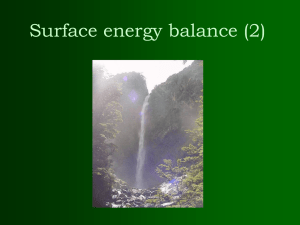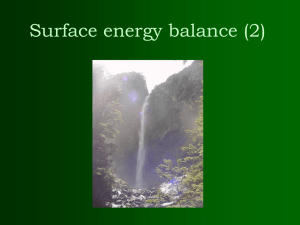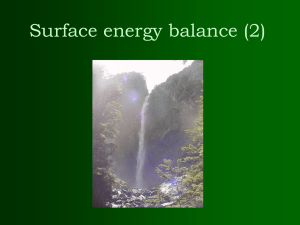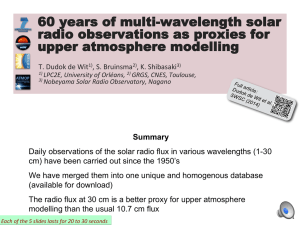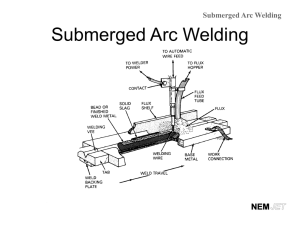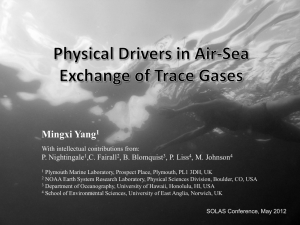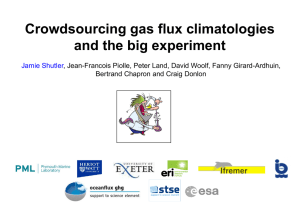Surface energy balance
advertisement
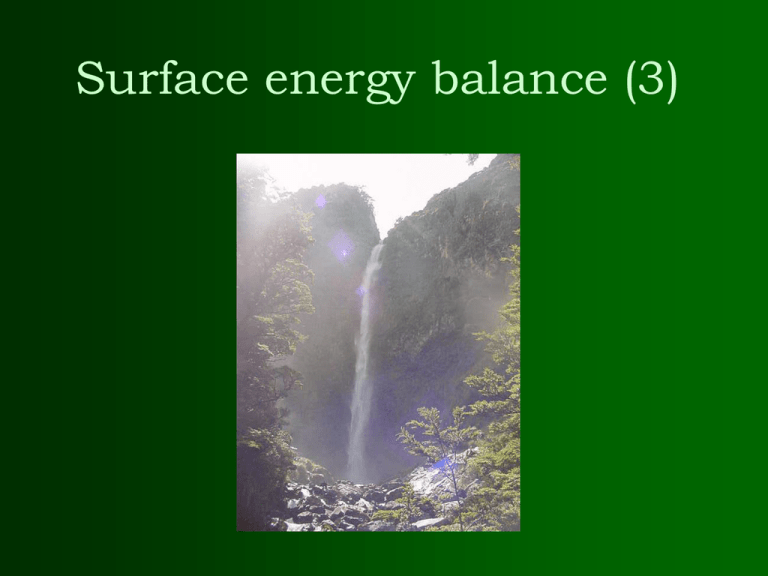
Surface energy balance (3) Review: Surface energy balance Incoming shortwave + Incoming longwave = Reflected shortwave + Emitted longwave + Latent heat flux + Sensible heat flux + Subsurface conduction SWdn =Scos SWup =SWdn LWdn LWup =Tair4 =Ts4 LH=CdLV(qsurface- qair) SH=CdCpV(TsurfaceTair) dT/dt Fc = - dT/dz Bowen ratio • The ratio of sensible heat flux to latent heat flux B = SH/LH Where SH is sensible heat flux, LH is latent heat flux • B = Cp(Tsurface - Tair) / L(qsurface - qair) can be measured using simple weather station. Together with radiation measurements (easier than measurements of turbulent fluxes), we can get an estimate of LH and SH Net radiative flux Fr = SWdn - SWup + LWdn - LWup Net turbulent flux Ft = LH + SH dT/dt Fd neglected From surface energy balance Ft = Fr (i.e. LH+SH = Fr) With the help of SH=B LH, we get LH=Fr/(B+1), SH=Fr B/(B+1) Bowen ratio (cont.) • When surface is wet, energy tends to be released as LH rather than SH. So LH is large while SH is small, then B is small. • Typical values: Semiarid regions: 5 Grasslands and forests: 0.5 Irrigated orchards and grass: 0.2 Sea: 0.1 Some advective situations (e.g. oasis): negative Map of Bowen ratio for Texas (By Prof. Maidment, U of Texas) River flow Latent heat flux Bowen ratio Subsurface conduction Fourier’s Law The law of heat conduction, also known as the Fourier’s law, states that the heat flux due to conduction is proportional to the negative gradient in temperature. In upper ocean, soil and sea ice, the temperature gradient is mainly in the vertical direction. So the heat flux due to conduction Fc is: Fc = - dT/dz where is thermal conductivity in the unit of W/(m K) Note that Fc is often much smaller than the other terms in surface energy balance and can be neglected Factors affecting the thermal conductivity of soil (Key: conduction requires medium) • Moisture content: wetter soil has a larger thermal conductivity • Dry density: denser soil has a larger thermal conductivity • Porosity • Chemical composition. For example, sands with a high quartz content generally have a high thermal conductivity • Biomass Other heat sources I: Precipitation • Rain water generally has a temperature lower than the surface temperature and therefore can cool down the surface • This term is generally smaller than LH and SH Other heat sources II: Biochemical heating • Biochemical processes (any chemical reaction involving biomolecules is called a biochemical process) may generate or consume heat • Examples: carbon and nitrogen transformation by microbial biomass Other heat sources III: Anthropogenic heat • Fossil fuel combustion • Electrical systems Summary: Surface energy balance Incoming shortwave + Incoming longwave = Reflected shortwave + Emitted longwave + Latent heat flux + Sensible heat flux + Subsurface conduction SWdn =Scos SWup =SWdn LWdn LWup =Tair4 =Ts4 LH=CdLV(qsurface- qair) SH=CdCpV(TsurfaceTair) dT/dt Fc = - dT/dz • Bowen ratio B= SH/LH = Cp(Tsurface - Tair) / L(qsurface - qair) provides a simple way for estimating SH and LH when the net radiative flux Fr is available LH=Fr/(B+1), SH=Fr B/(B+1) • Factors affecting soil thermal conductivity • Other heat sources: precipitation, biochemical, anthropogenic
